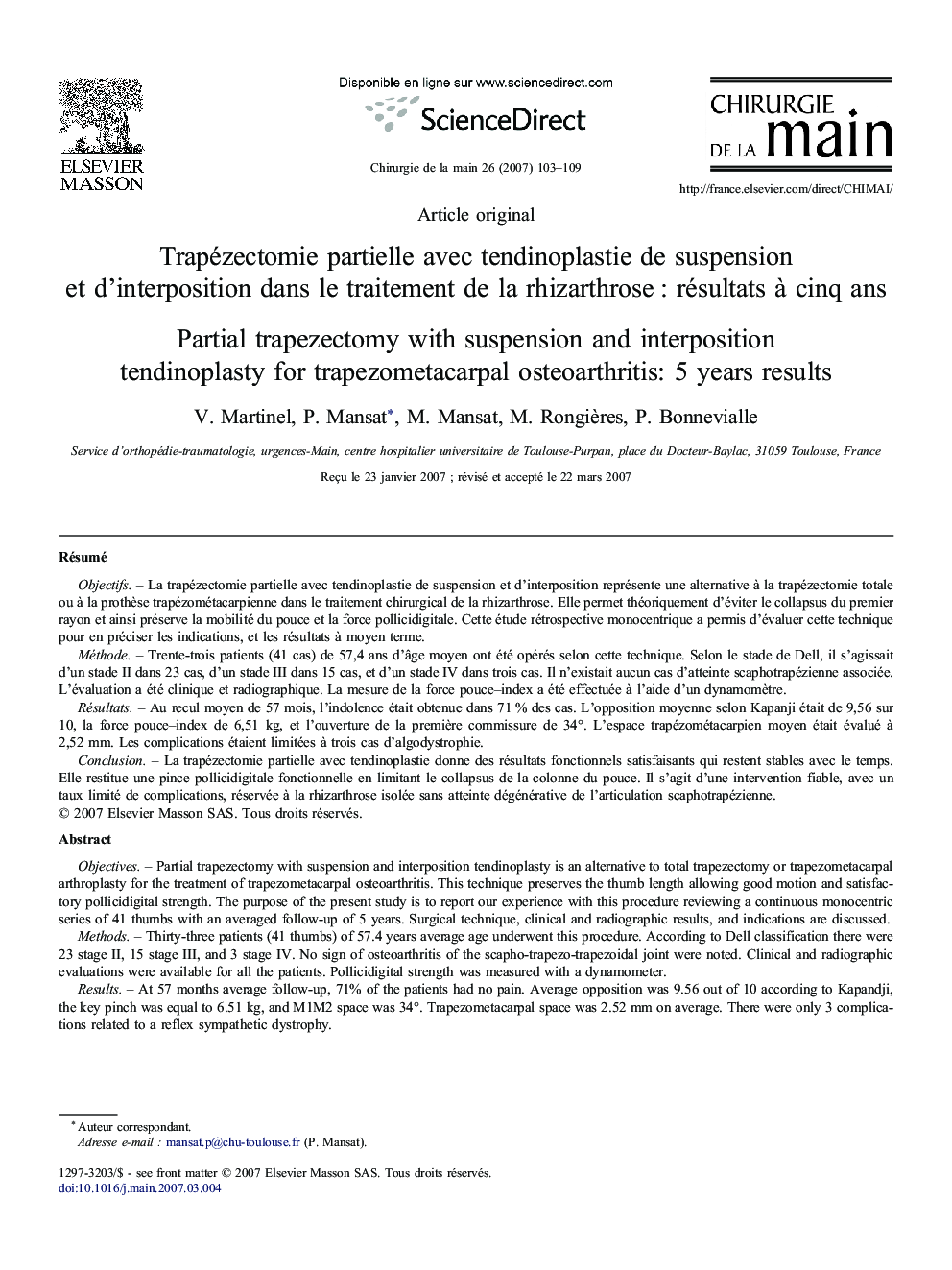| Article ID | Journal | Published Year | Pages | File Type |
|---|---|---|---|---|
| 4049790 | Chirurgie de la Main | 2007 | 7 Pages |
RésuméObjectifsLa trapézectomie partielle avec tendinoplastie de suspension et d'interposition représente une alternative à la trapézectomie totale ou à la prothèse trapézométacarpienne dans le traitement chirurgical de la rhizarthrose. Elle permet théoriquement d'éviter le collapsus du premier rayon et ainsi préserve la mobilité du pouce et la force pollicidigitale. Cette étude rétrospective monocentrique a permis d'évaluer cette technique pour en préciser les indications, et les résultats à moyen terme.MéthodeTrente-trois patients (41 cas) de 57,4 ans d'âge moyen ont été opérés selon cette technique. Selon le stade de Dell, il s'agissait d'un stade II dans 23 cas, d'un stade III dans 15 cas, et d'un stade IV dans trois cas. Il n'existait aucun cas d'atteinte scaphotrapézienne associée. L'évaluation a été clinique et radiographique. La mesure de la force pouce–index a été effectuée à l'aide d'un dynamomètre.RésultatsAu recul moyen de 57 mois, l'indolence était obtenue dans 71 % des cas. L'opposition moyenne selon Kapanji était de 9,56 sur 10, la force pouce–index de 6,51 kg, et l'ouverture de la première commissure de 34°. L'espace trapézométacarpien moyen était évalué à 2,52 mm. Les complications étaient limitées à trois cas d'algodystrophie.ConclusionLa trapézectomie partielle avec tendinoplastie donne des résultats fonctionnels satisfaisants qui restent stables avec le temps. Elle restitue une pince pollicidigitale fonctionnelle en limitant le collapsus de la colonne du pouce. Il s'agit d'une intervention fiable, avec un taux limité de complications, réservée à la rhizarthrose isolée sans atteinte dégénérative de l'articulation scaphotrapézienne.
ObjectivesPartial trapezectomy with suspension and interposition tendinoplasty is an alternative to total trapezectomy or trapezometacarpal arthroplasty for the treatment of trapezometacarpal osteoarthritis. This technique preserves the thumb length allowing good motion and satisfactory pollicidigital strength. The purpose of the present study is to report our experience with this procedure reviewing a continuous monocentric series of 41 thumbs with an averaged follow-up of 5 years. Surgical technique, clinical and radiographic results, and indications are discussed.MethodsThirty-three patients (41 thumbs) of 57.4 years average age underwent this procedure. According to Dell classification there were 23 stage II, 15 stage III, and 3 stage IV. No sign of osteoarthritis of the scapho-trapezo-trapezoidal joint were noted. Clinical and radiographic evaluations were available for all the patients. Pollicidigital strength was measured with a dynamometer.ResultsAt 57 months average follow-up, 71% of the patients had no pain. Average opposition was 9.56 out of 10 according to Kapandji, the key pinch was equal to 6.51 kg, and M1M2 space was 34°. Trapezometacarpal space was 2.52 mm on average. There were only 3 complications related to a reflex sympathetic dystrophy.ConclusionPartial trapezectomy with tendinoplasty gives satisfactory functional results which is maintained with follow-up. It allows recovery of a functional pollicidigital strength by limiting thumb shortening. It is a reliable procedure with a low rate of complication indicated for isolated thumb trapezometacarpal joint osteoarthritis without scapho-trapezo-trapezoidal joint involvement.
